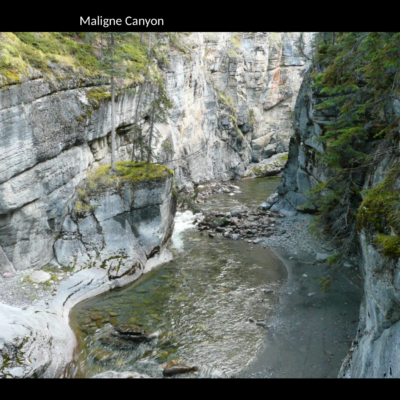By Joanne Moyer
I teach Environmental Studies and Geography at The King’s University in Edmonton, AB. Every September, our Physical Geography class goes to Jasper National Park to learn about mountain building, glaciers, karst landscapes, hot springs, etc. As the resident human geographer, I go along for the ride, hang out with students, and start musing about the theological lessons we might gain from rocks. Eventually, I turned these musings into a devotional that I share with the students and that I shared with the Mennonite Creation Care Network Council at our meeting in April.
Stubborn rock
On our Jasper trip, one of our first stops is at Abraham Lake, in the front ranges of the Rocky Mountains. Here we learn about how mountains form and then are shaped by glaciers. During the last glacial period, a great river of ice flowed through this valley. Then we have lunch on a rocky outcropping called Windy Point. We learn that this outcropping is made of limestone and it is here because limestone is very hard. It is so tough, it can resist 100 km of ice on top it, while all the sandstone and other rock was worn away.
We see this feature of limestone again when we hike up to the Athabasca Glacier, which is part of the Columbia Icefield, the largest icefield in the Rockies. Just before we reach the edge of the glacier, we must climb over a steep hill, which is also made of limestone. The receding glacier uncovered this hill about 40 years ago, so it has withstood that scouring glacier for over 2 million years!
As a stubborn sort of person, I really admire that kind of tenacity. It also reminds me of a verse in Romans:
I appeal to you therefore, brothers and sisters, by the mercies of God, to present your bodies as a living sacrifice, holy and acceptable to God, which is your spiritual worship. Do not be conformed to this world… (Romans 12:1-2a)
If the Apostle Paul had been on our field trip, he might have said, “Be like limestone; do not be conformed to this world.”
Worldliness can be defined as the systems that humans invariably construct based on power, status, security, and pleasure. These systems are not bad in and of themselves but become problematic when we turn them into idols and allow them to enslave us. So, the world, or glaciers, given the metaphor we’re playing with, are not all bad, but many things in the world have a shadow side that can twist them into negative influences and experiences. These may include:
- equating our self worth with performance (athletic, academic, career, etc.); or
- seeking a good job, and a house, and a car, and a retirement fund, before seeking the Kingdom of God.
And especially for folks in the environmental field:
- getting so caught up in the fight for climate justice or environmental preservation, that we forget to see God in those who don’t agree with us or stand in our way, and fail to love our enemies;
- believing that we are entirely responsible for solving all the problems and forgetting that God has a role; and
giving in to despair.
Open to transformation
So, we need to be strong, like limestone, to stay true to the path of discipleship that Jesus taught, seeking the Kingdom of God, loving God and loving our neighbor. At the same time, we must be careful, because sometimes we can focus so much on not conforming, on not giving in, that we lose our way in our very attempt to stay on it. We can become rigid and legalistic, for example, or miss opportunities to bring love and light to the world, because we’re so busy resisting it. And, of course, “not conforming” is not all there is to Romans 12. The whole verse says:
Do not be conformed to this world, but be transformed by the renewing of your minds, so that you may discern what is the will of God—what is good and acceptable and perfect. (Romans 12:2)
This is where the limestone comes in again, because while limestone is very resistant to being pushed around (literally), it is also very susceptible to chemical weathering. At Windy Point, we also look at the surface of the limestone, which is pitted because the small amount of acid that is naturally in rainwater can dissolve this rock. The next day, we go to Maligne Canyon, a spectacular feature shaped by a river flowing over (and through) limestone. Here we see how chemical weathering can take hard, stubborn rock, and transform it into something beautiful and amazing.
In the same way, renewing our minds and ourselves in Christ can help us to seek justice more, to love mercy and kindness more, and to walk more humbly with our God. And it can help us to love God with all our hearts and all our souls and all our minds and all our strength, to love our neighbor better, to love our enemies better, and to love ourselves better too. As you look at the photo shown, I invite you to meditate on the lesson of the limestone: there are times in our Christian walk when we need to hold firm and stubbornly refuse to conform. But we also need to be open to the transformation of God’s will and purpose so we can become beautiful, like a canyon!
